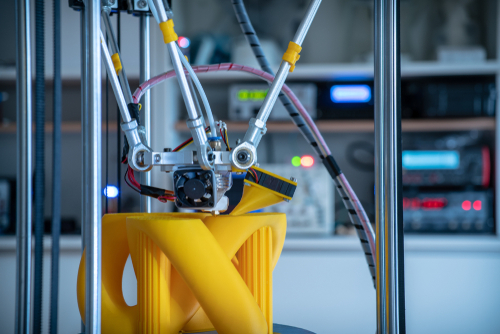The search for a suitable 3D printing technology is not easy with the large selection of additive production methods. Perhaps there are several technologies available for your requirements. In this article we would like to give you an overview of the differences between the various technologies in terms of their properties, their field of application and the materials used.
Binder Jetting (BJ)In binder jetting, different materials such as quartz sand or PMMA are bonded layer by layer by a binder.
Binder jetting is a fairly fast and inexpensive technology that works with a wide range of material types. Parts in full colour are possible. However, printed parts that come directly from the machine have limited machine properties, but with the appropriate post-processing they can meet your requirements.
Field of application: toolmaking, illustrative models, mould making
Usable materials: quartz sand, PMMA
Daylight Polymer Printing (DPP)
In the Daylight Polymer Printing process liquid plastics (photopolymers) are cured by a DPP projector.
Field of application: functional parts, master models, dummy construction
Usable materials: Photopolymer Daylight Firm, Photopolymer Daylight Flexible
Fused Deposition Modeling (FDM) / Fused Filament Fabrication (FFF)
Fused Deposition Modeling (FDM) or Fused Filament Fabrication (FFF) is a process in which wire-shaped plastic is melted and applied in layers to create a 3D print model. Thereby even complex parts can be manufactured without a supporting structure.
Field of application: illustrative samples, concept models, prototype construction
Usable materials: ABS, ABS-ESD7, PA 6, FDM Nylon 6?, PC, PC/ABS, PLA

Multi Jet Fusion (MJF)
In the Multi Jet Fusion, a carriage with ink jet nozzles travels over the printing area and places the fixing agent on a thin layer of plastic powder. At the same time, a detailing agent, which prevents sintering, is printed near the edge of the part. A powerful IR energy source then travels across the build bed and cuts through the areas where the fixative has been dispensed while leaving the rest of the powder untouched. The Multi Jet Fusion uses a print head to print the binder fluid into a plastic powder bed. The thermally conductive liquid binds the plastic powder.
Applications: Consumer products, architecture, aircraft industry
Usable materials: PA-12
Stereolithography (SLA)
In the SLA process, liquid plastics (photopolymers) are cured by a UV laser.
SLA printers are known for their ability to produce very detailed and complicated designs. The layers are chemically bonded together, not mechanically as in FDM. Thereby your models and small series benefit from a high mechanical strength.
Field of application: small series, model making, presentation media
Usable materials: Resin
Selective Laser Melting (SLM)
Both Selective Laser Melting (SLM) and Direct Metal Laser Sintering (DMLS) produce parts using a process similar to SLS. The main difference is that SLM and DMLS are used in the production of metal parts. SLM achieves complete melting of the powder, while DMLS heats the powder to almost melting temperature until it chemically fuses together. DMLS only works with alloys (nickel alloys, Ti64, etc.), while SLM can use single component metals such as aluminum. In contrast to SLS, SLM and DMLS require supporting structures to compensate for the high internal stresses during the construction process. This helps to limit the likelihood of distortion and warping. DMLS is the most widely used metal AM process with the largest installed base: Selective Laser Melting is the melting of metal powder layer by layer by a laser.
Field of application: Automotive industry, mechanical engineering, spare parts
Usable materials: 1.2709, 1.4404, AlSi10Mg, Corrax, CuCr1Zr, TiAl6V4
Selective Laser Sintering (SLS)
SLS produces solid plastic parts using a laser to sinter thin layers of powdered material layer by layer. The process begins with the application of a first layer of powder onto the building platform. The cross section of the component is scanned by the laser, sintered and solidified. The building platform then drops by one layer thickness and a new powder layer is applied. The process is repeated until a solid part is produced. The result of this process is a part completely encased in unsintered powder. The part is removed from the powder, cleaned and is then ready for use or can be refined by post-processing.
Field of application: Concept models, design and art, functional prototyping
Usable materials: Alumide, DuraForm? HST, DuraForm? Flex, PP, PA 12 - GF, PA 2241 FR, TPU
Other additive manufacturing technologies
Of course there are other technologies that are used in 3D printing. Especially for the printing of metallic components. We have now focused on these 7 technologies because they are currently the most widely used and are also available through the Jellypipe 3D ecosystem.
Test our online 3D printing platform!

